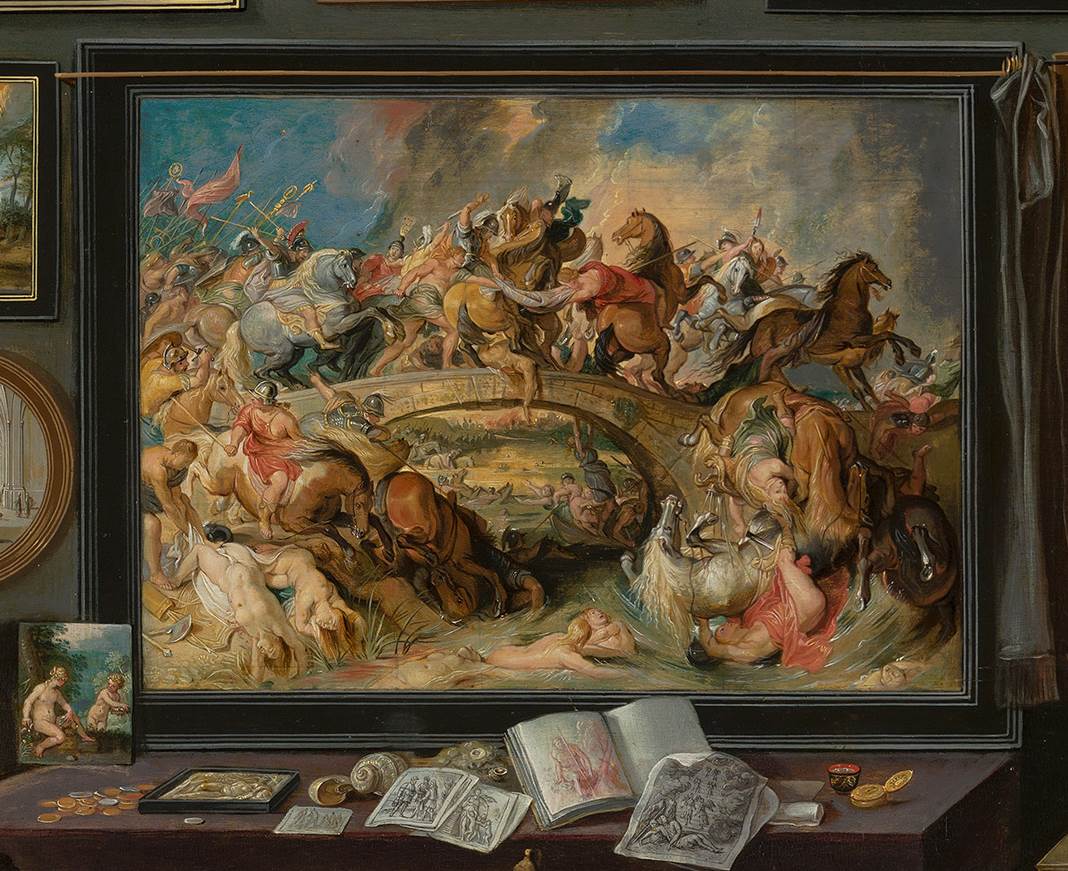The Antwerp painter Willem van Haecht left an extremely small oeuvre: today, only three paintings and a small number of prints are known. The paintings all depict Kunstkammers, interiors filled with paintings and other art objects. The painting in the Mauritshuis is the largest; there are slightly smaller versions in the Rubenshuis in Antwerp and in a private collection.
Van Haecht was the son of Tobias van Haecht (or Verhaecht), Rubens’ first teacher. Willem van Haecht was registered in Antwerp painters’ guild from 1626 or 1627 as an independent master, and at the same time he worked as curator of the art collection of Cornelis van der Geest (1555-1638), a prominent collector and patron of Rubens. In that capacity Van Haecht was responsible for the presentation and preservation of the large collection of paintings and decorative arts. Van Haecht’s Kunstkammers constitute an imaginary museum with art treasures that the curator/painter saw around him every day, along with works by Italian painters that were certainly not in Antwerp. So the ensembles presented in these paintings never appeared in this manner in reality.
In this Kunstkammer, over fifty paintings decorate the walls of a large room and the hall behind it. Over half of them were painted by Flemish masters. Occupying a place of honour above the table on the left is the impressive Battle of the Amazons, which Rubens painted for Cornelis van der Geest around 1615 and which now hangs in the Alte Pinakothek, Munich. In the far right foreground we are immediately struck by Quinten Massys’s Money-Changer and His Wife, now in the Musée du Louvre in Paris. The sixteenth-century artist Massys (or Metsijs) was regarded by Van Haecht and his contemporaries as the founder of the Antwerp school of painters, while Rubens was seen as the greatest contemporary painter. A flower piece by Daniel Segers, a market scene by Joachim Beuckelaer, and a hunting scene painted by Jan Brueghel the Elder and Peter Paul Rubens are on the floor in the front, while at the far left, high up on the wall, is a hunting still life by Frans Snijders and The Taking of Samson, an early history piece by Anthony van Dyck.
This creates the impression that Van Haecht has set out to present an ode to Flemish painting. In this respect the painting does not at first sight differ from similar scenes by other Flemish masters like Jan Brueghel the Elder (1568-1625) or David Teniers the Younger (1610-1690). On further inspection, however, this scene proves to be more complex. At lower left Van Haecht has depicted an episode from the story of Apelles and Campaspe, which is related by Pliny the Elder among others. Apelles, court painter to Alexander the Great, falls hopelessly in love when he has to paint Campaspe, the king’s most beautiful concubine, nude as Venus. Alexander notices his lovesickness and gives him Campaspe as his wife when the portrait is finished. In a departure from the literary and pictorial tradition, Campaspe is not rendered nude here. Another of Van Haecht’s own inventions is his depiction of Campaspe posing as the most beautiful of three ravishing courtesans. As an allusion to their beauty, one of the women is holding a print, The judgment of Paris by Marcantonio Raimondi after Raphael. So the painter has contrived to intersperse another tale from antiquity here. Paris has to choose the most beautiful of three goddesses – Juno, Minerva and Venus. He chooses Venus, who represents sensual love – the kind of love with which Apelles is consumed.
Since the story of Apelles deals with a ruler who treated his court painter with the greatest of respect, it has understandably always been a popular subject with artists. In fact Apelles became the personification of the art of painting. The painters of Antwerp’s St Luke’s Guild were praised in 1619 as ‘Students faithful to the art of Apelles’. And Rubens was called ‘the Apelles of our age’ in the seventeenth-century literature of art, because he also worked for princes and seemed to consort with them on equal terms. Rubens’s world is certainly a very strong presence in this scene. We see his own paintings in prominent places in addition to an abundance of work by his pupils and older painters he admired. Numerous details in the architecture of the Kunstkammer, too, refer to the great master of Flemish painting. For instance, the semicircular niche bounding the back room has been copied from Rubens’ mouseion of his house in Antwerp. Here stood the antique sculptures that he had acquired in 1618, illuminated by an oculus in the top of the dome.
On 11 July 1637 Willem van Haecht, lying in his sickbed, drew up his last will and testament. He bequeathed his masterpiece to his employer Cornelis van der Geest. The next reference to Apelles Painting Campaspe dates from 1765, when it was acquired by stadholder William V at the auction of the collection of the king of Poland.
(this is a reworked version of a text published in in: P. van der Ploeg, Q. Buvelot, Royal Picture Gallery Mauritshuis: A princely collection, The Hague 2005)








